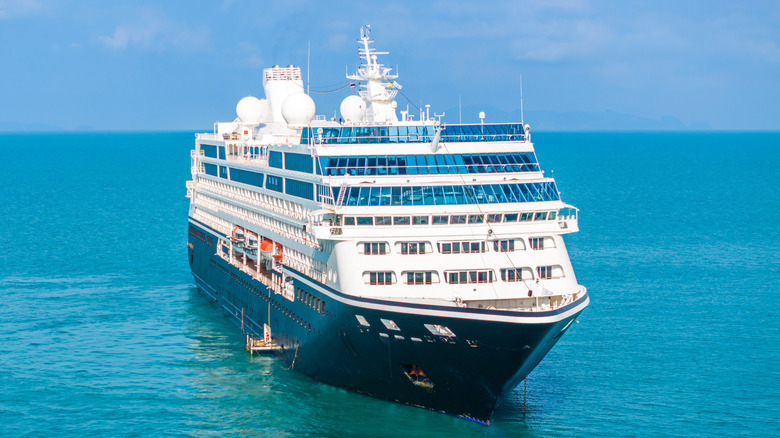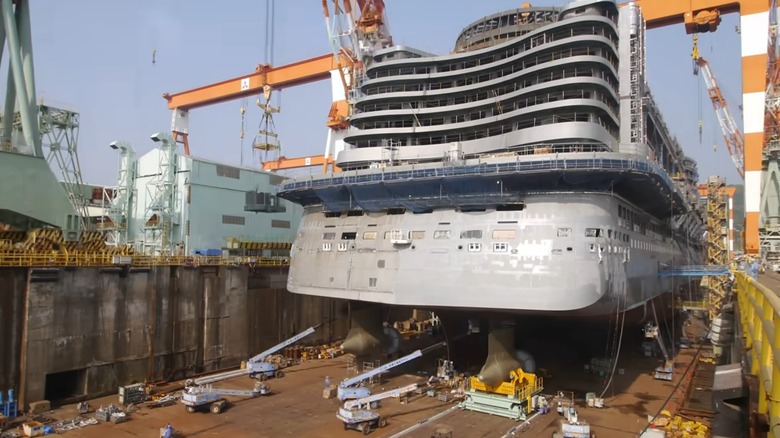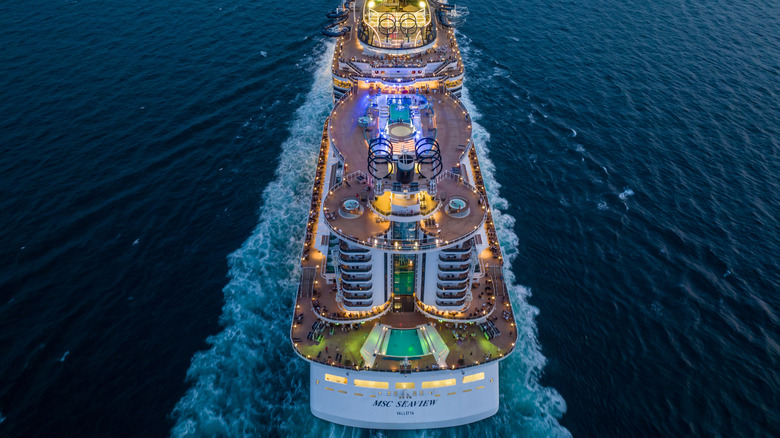How Long Does It Take To Build A Cruise Ship?
The current era has seen many technological marvels take the world by storm, with the cruise ship — not to be confused with the ocean liner — being one of the most impressive. These massive, multi-level ships are capable of carrying thousands of passengers while also providing them with the amenities they expect during a luxury vacation. On top of all that, there's more to them than meets the eye with some cruise ships coming with secret tech to fight off modern pirates. Of course, it goes without saying that all of this doesn't just appear out of nowhere. It takes effort, money, and a strong work force to construct cruise ships, in addition to plenty of time.
Given their massive size and vast capabilities, it's no surprise that cruise ships aren't built overnight. They can take quite a long time to complete. For instance, the Disney Wish cruise ship, built by Meyer Werft, took around 10 months to construct. Other cruise ships have been known to take between two and three years to finish. Overall, like with any major construction project, this timetable can change depending on everything from funding to material availability to unforeseen setbacks that are encountered during the building process. At any rate, cruise ships are far from an overnight build.
Regardless of the technology and resources at one's disposal, building a cruise ship takes an incredible amount of time. As a result, builders have found innovative and highly effective ways of reducing build time without compromising quality.
Ways to decrease a cruise ship's build time
To meet the demand for cruise ships, the companies making them have refined the building process in an effort to reduce their mammoth construction times. One of the most notable is the use of modularity, where teams of builders construct separate parts of the ship on their own before putting them all together. Before building begins, the ship is broken down digitally via computer modeling software into sections, ultimately resulting in 80 total portions. These are built separately and then welded and wired together once construction is complete. With that, the ship is ready for the high seas.
Another method of reducing construction time is pretty self-explanatory: not building a cruise ship from scratch at all. In some cases, cruise ships are entirely usable, but could be lacking room for passengers or on-board events. In these instances, these ships go through a process called jumboization, wherein an existing ship is pulled apart and a new section constructed in the gap. The entire ship is then reassembled.
Between constructing new cruise ships and adding onto existing ones, a lot of time and money is used up. Therefore, one has to ask how much work can a company realistically get out of a cruise ship and does it justify these exorbitant expenses?
How long do cruise ships last?
Waiting years upon years for a cruise ship to be built, tested, staffed, and eventually put to use makes these ships a long-term investment. Fortunately for those who put in the work to make them, and put up the funds to have them built, typically, cruise ships last quite a long time on the high seas. While there's no hard-and-fast rule for how long they remain in service, in most cases, cruise ships will be put to use for around 30 years. After this, the ships can be used in many other ways from being converted into hotels to becoming artificial reefs to going to scrapyards where they're disassembled for parts.
As mentioned, however, there's no strict guideline stating ships must be retired after 30 years of service. Throughout the decades, several ships have served the public for far longer. For example, the Astoria — formerly known as the Stockholm — was built back in 1948 and only retired in 2020, clocking in total 72 years of service. The Funchal is another example of a long-running cruise ship, having been built in 1961. It remained on the water into the 2010s. In the early 2020s, strides began to be made to convert it into a hotel.
It's easy to get lost in aspects like the size, grandeur, and the remarkable speed of cruise ships, to the point that the work put into getting them on the ocean is often overlooked. However, one could certainly argue that the time, effort, and funds put into their construction is just as impressive as the end result.


